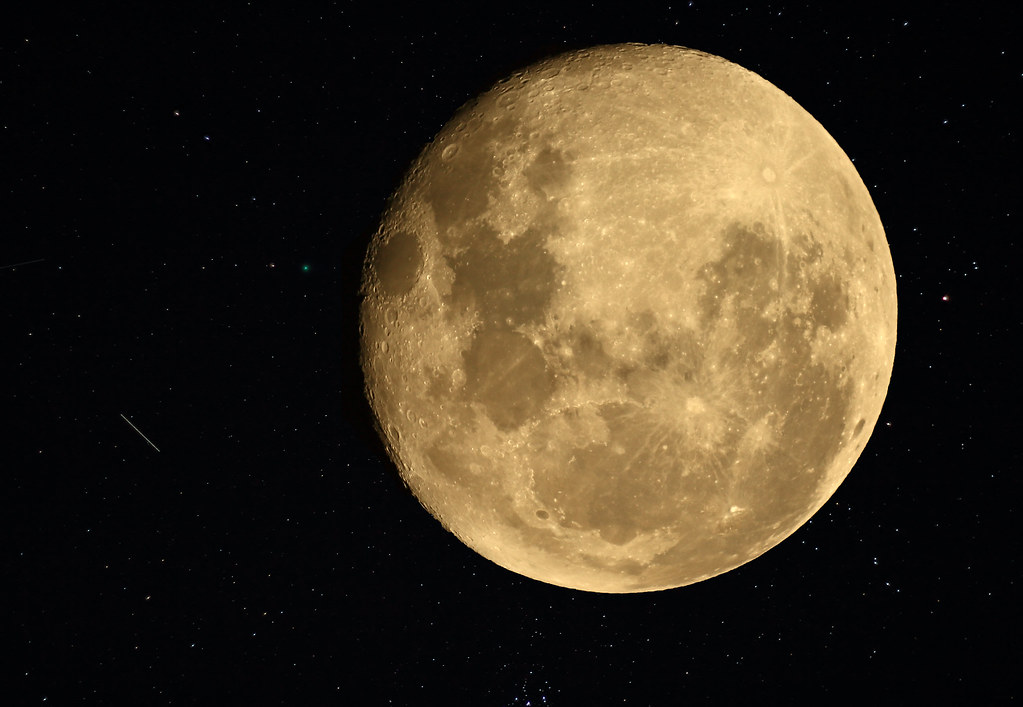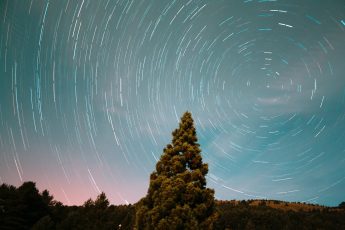The Celestron NexStar 4SE is a fine beginner’s telescope. It’s relatively inexpensive and has a database of objects you can search to find celestial bodies. However, its short optical tube isn’t excellent for astrophotography, so don’t expect to capture amazing photos if that’s what you want.
NexStar 4SE Computerized Telescope Key Specifications
| Feature | Specification |
|---|---|
| Optical Design | Maksutov-Cassegrain |
| Aperture | 102 mm (4.02″) |
| Focal Length | 1325 mm (52″) |
| Focal Ratio | f/13 |
| Magnification | 53x |
| Limiting Magnitude | 12.5 |
| Low Useful Magnification | 15x |
| High Theoretical Magnification | 241x |
| Assembled Weight | 21 lbs |
| Mount Type | Fully-automated GoTo |
| Celestial Object Database | 40,000+ objects |
| Warranty | 2-Year US Warranty |
| Software Included | Starry Night Special Edition |
- Nexstar computerized telescope: The NexStar 4SE Computerized Telescope features Celestron’s iconic orange tube design with updated technology and the latest features for amazing stargazing for beginners and experienced observers.
- 4-Inch aperture: The 4-inch primary mirror in this Maksutov-Cassegrain telescope for adults and kids to be used together packs enough light-gathering ability to observe the best that our Solar System has to offer, while retaining a compact form factor.
- Fully-automated go to mount: Featuring a database of more than 40,000 celestial objects, the go to mount built into our telescopes for astronomy beginners automatically locates and tracks objects for you.
- Bonus free starry night software: The NexStar 4SE Telescope includes a FREE download of one of the top consumer rated astronomy software programs for an interactive sky simulation.
Prices pulled from the Amazon Product Advertising API on:
Product prices and availability are accurate as of the date/time indicated and are subject to change. Any price and availability information displayed on [relevant Amazon Site(s), as applicable] at the time of purchase will apply to the purchase of this product.
As an Amazon Associate, we earn from qualifying purchases.
Pros and Cons of the NexStar 4SE Computerized Telescope
Pros
- Advanced Optics and Features: The NexStar 4SE Computerized Telescope comes with 4-inch Maksutov-Cassegrain optics, which provide an impressive light-gathering ability for viewing the Moon, planets, and deep-sky objects. The telescope also features Celestron’s advanced StarBright XLT coatings for better light transmission and more explicit images.
- User-friendly and Easy to Set Up: The telescope is designed for easy assembly and disassembly, with a quick-release fork arm mount, optical tube, and accessory tray that require no tools. In addition, the built-in SkyAlign technology allows fast alignment with just three bright celestial objects.
- Fully-automated GoTo Mount: The NexStar 4SE features a GoTo mount with a database of over 40,000 celestial objects, making it easy for beginners to locate and track objects in the sky. In addition, the mount is compatible with advanced accessories such as StarSense AutoAlign and SkySync GPS.
- Portable and Compact: Weighing just 21 pounds, including the tripod, the NexStar 4SE is easily transportable and ideal for beginners and experienced astronomers.
- Excellent Warranty and Support: The telescope comes with a 2-year US warranty and unlimited support from Celestron’s team of US-based experts, providing peace of mind for buyers.
- Bonus Free Starry Night Software: The NexStar 4SE includes a free download of the highly-rated Starry Night Special Edition software, allowing users to simulate the night sky, learn about celestial objects, and plan observing sessions.
Cons
- Limited Astrophotography Capabilities: While the NexStar 4SE is equipped with a built-in wedge for short-exposure astrophotography, it may not be suitable for those looking to capture long-exposure images of deep-sky objects.
- Power Source: The internal battery compartment may require frequent changes, and an external power source may be needed for extended use.
- Focal Ratio: The telescope’s f/13 focal ratio might limit the brightness and field of view for certain deep-sky objects.
Summary
The NexStar 4SE Computerized Telescope offers a great combination of advanced optics, user-friendly features, and portability. It is ideal for beginners and experienced observers looking for a compact, easy-to-use telescope with a powerful GoTo mount. The main drawbacks are its limited astrophotography capabilities and the potential need for an external power source for extended use. Overall, the NexStar 4SE is a valuable investment for those interested in exploring the night sky.

Short optical tube
Short optical tubes are the most portable and convenient choice for beginners and long-time astronomers. Their compact design makes them easy to transport, store and set up. For example, a short tube telescope can be set up or transported in a car trunk or hatchback without taking out seats.
If you’re new to astronomy, you may want a portable, easy-to-use, inexpensive telescope. Short optical tubes are generally less expensive than longer ones because they don’t require heavy mountings or large lenses (and, therefore, less glass). They also tend to be lighter than long optical tubes with similar aperture diameters (diameter = opening size).

Database of objects
The NexStar 4SE has a database of over 40,000 objects. They are sorted by type (categories such as galaxies and nebulas), distance, brightness, size, and mass. While some may find this overwhelming at first glance, it’s easy to use once you figure out how the system works—and it’s pretty simple!
For example, if you’d like to look up an object near Earth in our solar system (like Mars), choose “Solar System” from the list on your hand controller. However, if there’s something specific you want to see (like Jupiter), then select “Solar System: Planets” or “Solar System: Moons” if you’re interested in seeing those instead.
For the viewer on a budget
The Celestron NexStar 4SE is a solid choice for the viewer on a budget, but it’s not the best option for deep-sky objects or astrophotography. However, this model is an excellent starting point if you want to get your feet wet with an amateur telescope without breaking the bank.

The Celestron NexStar 4SE costs less than $600 and includes several valuable features that make it easy to use. It also has excellent portability: It can be folded into its carrying case, so you can easily take it anywhere.
Not great for astrophotography
This telescope is not great for astrophotography or deep sky imaging.
For visual astronomy and solar system objects, the NexStar 4SE is a fine instrument. However, if you’re looking for a scope that will allow you to capture images of deep space objects such as nebulae or galaxies (aka “astrophotography“), this isn’t the scope for you. The 60mm aperture on this telescope limits what types of photos you can take; it’s not powerful enough to gather enough light from dimmer celestial targets like nebulae and galaxies.
That said, if your interests lean more toward terrestrial viewing—for instance, observing wildlife or landscapes—then this telescope could be right up your alley! Its small size makes it easy to transport around town and set up quickly wherever there’s room for stargazing between all those other activities.

Celestron’s NexStar 4SE is a great first telescope for beginners.
The Celestron NexStar 4SE is a great first telescope for beginners. It’s easy to set up and use, with a database of objects to look at, and comes with its handheld controller, so you don’t need to fumble around with your smartphone. However, it cannot attach an autoguider or reflex camera for astrophotography.
The NexStar 4SE is a short optical tube that features Celestron’s SkyAlign alignment technology (a database of over 40,000 objects) and their StarSense AutoAlign system, which uses GPS coordinates to align the telescope using just your phone or tablet automatically.
If you don’t have access to either of those things at night, then this telescope can still find and track celestial bodies by itself without any user input required other than picking which side they want most visible on screen (either left or right).
This model has been designed specifically for astrophotography enthusiasts but doesn’t include features like setting up an autoguider system or attaching cameras directly onto it – though adapters are available separately if needed!
Conclusion
Celestron’s NexStar 4SE is a great first telescope for beginners. It’s easy to set up, comes with an easy-to-use database of objects, and includes extra features like WiFi connectivity. In addition, the short optical tube won’t be too heavy or bulky for users who need to carry their telescopes around as they explore the constellations.
Unfortunately, this model will not be ideal for astrophotography users due to its lack of motorized tracking systems, which can introduce noise into images taken over long periods without movement from the mount itself – though if you’re interested in taking pictures instead, don’t worry! You’ll still get great shots using manual settings on any Celestron product line up until level 5, which means plenty more options are available, including those mentioned above.
















